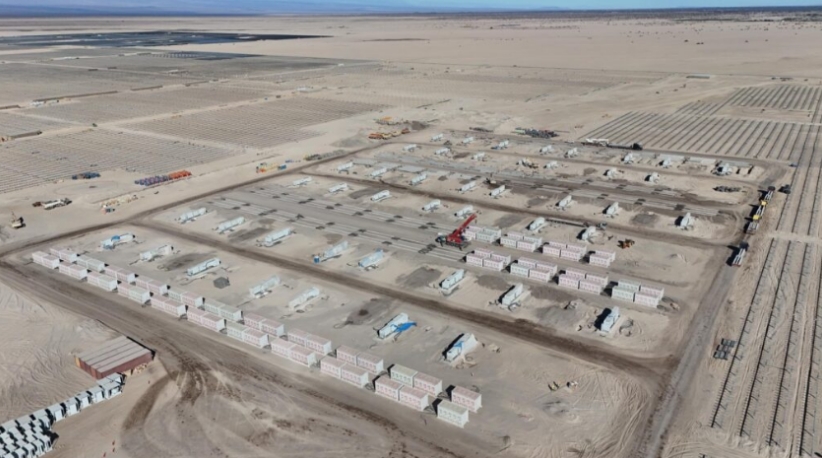Recently, the Latin American Energy Organization (OLADE) released a technical report stating that 2.5GW energy storage systems have been deployed in the Latin American and Caribbean region (LAC), and recommendations have been made for energy storage projects in Chile, Brazil, Mexico, Argentina, and other countries for operation and planning.

Grenergy's Oasis de Atacama solar+energy storage project developed in Chile
The continuous increase in the share of renewable energy generation and the limitations of grid infrastructure are the main driving forces for energy storage deployment in the region. Chile, Brazil, and Mexico are leading the way, while Central American and Caribbean countries mainly deploy small-scale energy storage projects.
In terms of technological roadmap, lithium-ion battery energy storage systems account for 60% of the total energy storage capacity in the region and are widely used in solar+energy storage projects as well as independently deployed energy storage projects. Argentina and Brazil are mainly constructing pumped storage power stations (PHES), while Chile has deployed some thermal energy storage facilities. In addition, industrial users in the region have also installed some small-scale energy storage systems.
Overview of Operational Projects in Latin America and the Caribbean
Chile: As of June this year, Chile has deployed a total of 1005MW energy storage systems. The report focuses on the Oasis de Atacama solar+energy storage project developed by Grenergy in the Atacama Desert. The project is scheduled to commence construction in 2024, with a total planned supporting capacity of up to 11GWh of battery energy storage system. Last year, 1.24GWh was put into operation. In May of this year, the Capricornio solar+energy storage project was put into operation, with a supporting battery energy storage system scale of 48MW/264MWh. As of May 30th, Chile has 5 energy storage projects in the commissioning stage, with a total installed capacity of 571 MW and an energy storage capacity of 2378 MWh.
Brazil: According to research data from Grenergy, OLADE cited that Brazil deployed approximately 269 MWh of energy storage systems last year, a year-on-year increase of 29%. As of the end of last year, a total of 685MWh of energy storage systems had been deployed, with 70% serving off grid systems.
Argentina currently has a 17.5MW battery energy storage system and a 974MW pumped storage power generation facility.
Mexico: It already has a 192MW lithium-ion battery energy storage system and plans to carry out other projects to support grid operation and integrate renewable energy.
Other countries: Honduras approved the deployment of a 75 MW/300 MWh battery energy storage system in March this year. Peru has a 26.5MW battery energy storage system.
Energy storage projects under construction
Chile and Brazil are leading the way in building large-scale battery energy storage systems and pumped storage power generation facilities (PHES), while countries such as Costa Rica, El Salvador, and Colombia focus on developing grid backup facilities and microgrids in remote and rural areas. OLADE expects that there will be no large-scale deployment of technologies such as gravity energy storage systems or flywheel energy storage in Latin America and the Caribbean this year.
development trend
Although the development level of energy storage markets varies among countries in Latin America and the Caribbean, OLADE has observed that most Latin American and Caribbean governments have incorporated energy storage systems into their energy planning, climate policies, and electrification strategies. Although the corresponding regulatory framework is not yet perfect, the currently deployed energy storage projects are mostly concentrated in rural, island, and weak grid areas, and usually receive support from international development finance institutions. Multilateral institutions such as the Inter American Development Bank (ADB), World Bank (WB), and Latin American Development Bank (CAF) have provided financing, technical assistance, and institutional support for energy storage projects.
Challenges Faced
OLADE pointed out that the lack of regulatory support for energy storage systems often means that their technical positioning is vague and their role in the power system is unclear. This has led to the insufficient recognition and reasonable compensation of the value of energy storage systems in strengthening the power grid by providing frequency regulation, backup power, or demand shifting (peak shaving and valley filling). In addition, the energy storage system has not been included in the long-term expansion plan of the power grid, and the uncertainty of the regulatory environment further exacerbates the difficulty of project financing.
Suggestions given
OLADE calls for the establishment of clear energy storage deployment policies and regulatory frameworks in Latin America and the Caribbean, including defining energy storage systems as generation, consumption, grid ancillary services, or independent categories. The compensation mechanism should reflect the grid strengthening value of energy storage systems and promote market participation in an environment of fair competition with other energy technologies. Energy storage systems need to be included in energy planning policies, open up grid access, support multi-purpose applications, and develop technical and safety standards.
OLADE suggests providing incentives such as tax breaks, investment credits, and subsidies for demonstration projects in remote areas. Public funds should support the secondary utilization of retired batteries, thermal energy storage, and hydrogen energy development, and design special energy storage plans for areas with insufficient power supply.
Preferential financial policies such as green credit, partial guarantees, international climate financing, and incorporating energy storage systems into leasing and energy service contracts can reduce investor risks. In addition, OLADE suggests encouraging the deployment of residential and commercial energy storage through capacity reserve payments, joint auctions of renewable energy and storage, dynamic tariffs or net metering policies.

